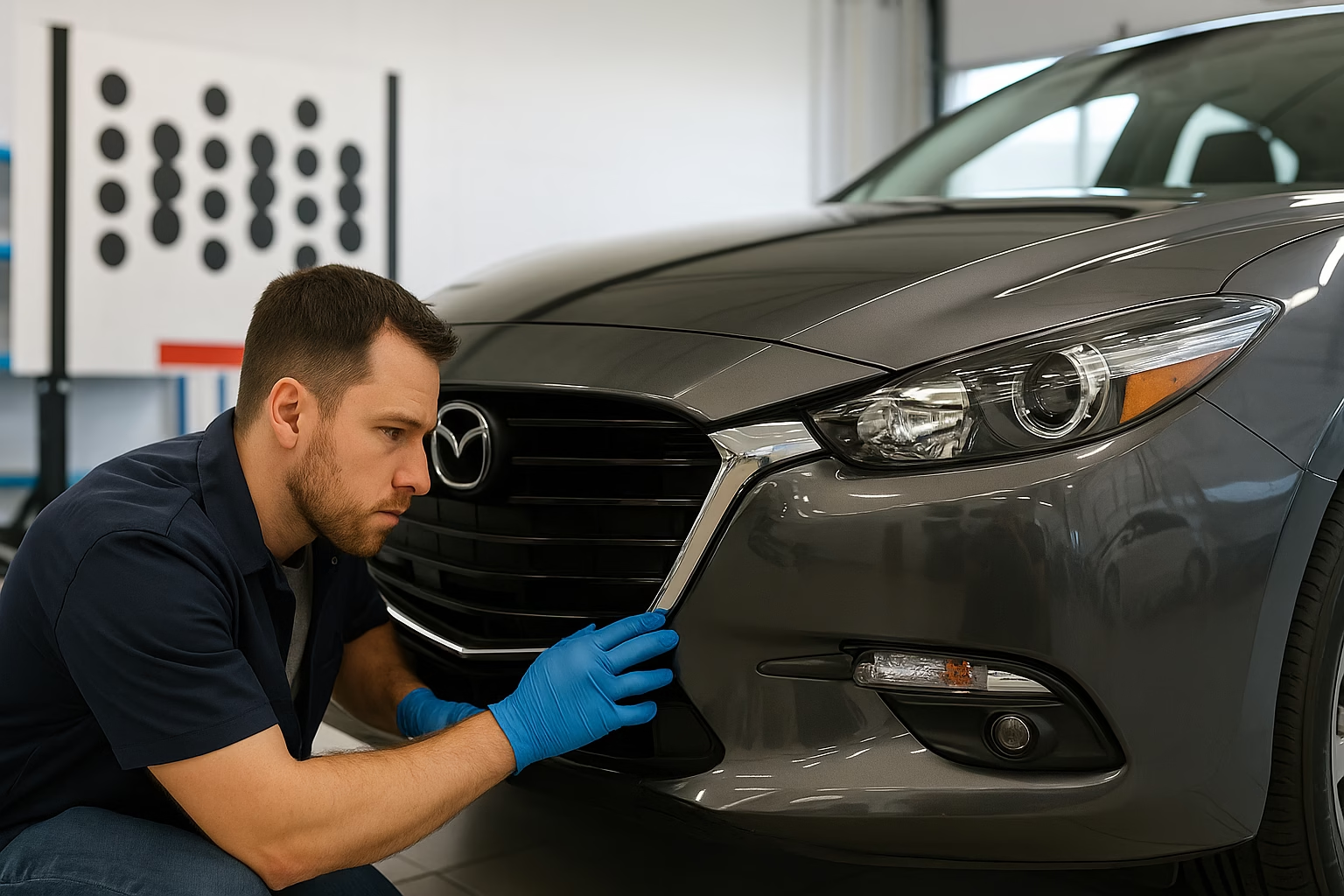Advanced driver assistance systems rely on precise sensor alignment. Cameras must see through glass with specific optical properties, radar units must beam through plastic covers with known thickness, and ultrasonic sensors are tuned to acoustic characteristics. When you replace a windscreen or bumper with an aftermarket part, even small deviations in materials or mounting can disrupt the tight tolerances that manufacturers assume. This article examines how aftermarket windscreens and bumpers differ from original equipment, why those differences matter to calibration tolerances and what technicians should do when fitting and calibrating these components.
Aftermarket windshields and optical considerations
The forward-facing camera mounted at the top of the windscreen is one of the most critical ADAS sensors. It reads lane markings, traffic signs and vehicles ahead through a specific window of glass. OEM windscreens are manufactured with strict control over thickness, refractive index and optical distortion. The camera bracket is bonded at a defined angle, and the glass has a clear area with minimal tinting or heating elements. Aftermarket windscreens may meet minimum safety standards but can have slight variations in curvature, thickness or tint. The polyvinyl butyral interlayer may be thicker, the glass may have different coatings or there may be distortion at the edges. Even a tiny variation can change the way light enters the camera, leading to inaccurate lane detection or calibration drift.
Another issue is mounting accuracy. Some aftermarket windscreen suppliers reuse the original bracket, while others supply universal brackets that rely on adhesive pads. If the bracket is not positioned within a few tenths of a millimetre of the OEM specification, the camera will be pitched or yawed relative to the road. This misalignment may not be obvious to the human eye, but the calibration routine will produce out-of-range values or may not complete. To maintain tolerances, technicians should use OEM replacement glass or choose aftermarket brands that are certified for ADAS compatibility. Always transfer the original camera bracket or purchase one designed to match the factory angle. Use the recommended primer and adhesive and follow the curing times so the bracket does not shift during calibration.
Bumper covers, radar and ultrasonic sensors
Radar units used for adaptive cruise and collision avoidance are often hidden behind the front bumper cover. These radar modules emit and receive millimetre-wave signals that are sensitive to the thickness and dielectric properties of the material in front of them. The factory bumper cover is engineered with a specific plastic composition and paint thickness; heavy metallic paint or metal flake can attenuate the radar signal. Aftermarket bumpers may use different plastics, add styling ribs or have thicker layers of filler and paint. Even the positioning of the radar mounting bracket can vary due to manufacturing tolerances or damage repairs. This alters the phase of the radar waves and can reduce detection range or cause false targets.
Ultrasonic sensors used for park assist and blind spot monitoring are also affected by material properties. Bumper covers with thicker foam backing or different density plastics can change how sound waves reflect. Aftermarket bumpers designed for aesthetics may obscure sensor openings or position them at a slightly different height. Some off-road bumpers or bull bars reposition sensors entirely, making OEM calibration procedures invalid. Technicians fitting these parts must ensure that sensor holes are in exactly the same location and orientation as the original part and that the material thickness does not exceed the manufacturer’s tolerance. If modifications alter these parameters, the system may not achieve correct range calibration.
Understanding calibration tolerances
Calibration procedures for cameras and radar specify extremely tight tolerances. A forward-facing camera might need to be within 0.1 degrees of the vehicle’s longitudinal centreline and within 2 mm of the original height. Radar modules may require mounting surfaces that are absolutely level and positioned within a millimetre of the design point. These tolerances account for sensor technology limitations and the physics of light and radio waves. Aftermarket windscreens and bumpers that are out of spec effectively shift the sensor and exceed the allowed tolerance. Even if a calibration completes, the sensor may operate at the edge of its performance envelope, leading to reduced detection accuracy in certain conditions.
Recognising out-of-tolerance components is not always straightforward. A vehicle may appear to calibrate successfully even when a sensor has marginal alignment or is partly occluded. Warning signs include calibration values that are at the extreme ends of specified ranges, repeated dynamic calibration failures on test drives, or customers reporting reduced performance after a repair. When technicians encounter these situations, they should carefully examine the parts fitted: measure glass thickness, check that bumper covers have the correct part number, and verify that bracket tolerances match factory dimensions. If necessary, replace the aftermarket part with an ADAS-certified component.
Best practices for aftermarket parts and calibration
To minimise issues, workshops should adopt clear procedures whenever a windscreen or bumper is replaced. Before removal, document the existing sensor positions and collect any calibration reports. Choose replacement parts from suppliers that explicitly state ADAS compatibility and provide evidence of conformity. Use manufacturer-approved adhesives, primers and mounting hardware, and follow curing times to ensure the camera or radar bracket does not move. After installation, perform the recommended static or dynamic calibration routine in a controlled environment with level flooring, proper lighting and free of metal objects. Record all alignment values, ambient conditions and software versions. If the calibration values are near the limits or the system fails verification tests, do not return the vehicle until the cause is resolved—either by repositioning the bracket or replacing the part. Educate customers that certain aftermarket styling modifications may require additional calibration steps or may not be compatible with their ADAS sensors. By following these practices, technicians can maintain calibration tolerances and uphold the safety performance of the vehicle.

Hiran Alwis is an automotive lecturer and ADAS specialist with over 15 years of experience in diagnostics, advanced safety systems, and technical training. He founded ADAS Project to help everyday drivers and workshop technicians understand and safely use advanced driver assistance systems.
